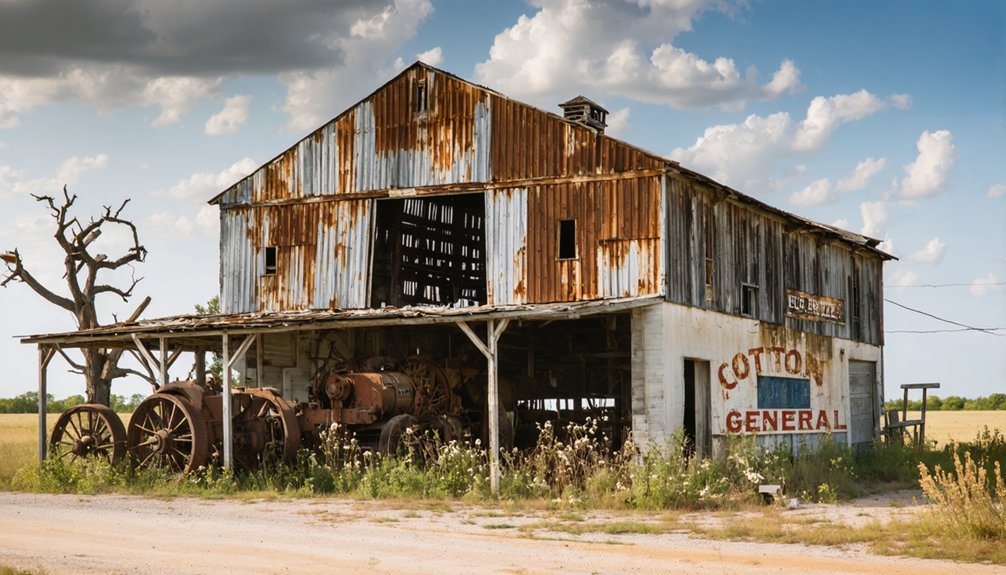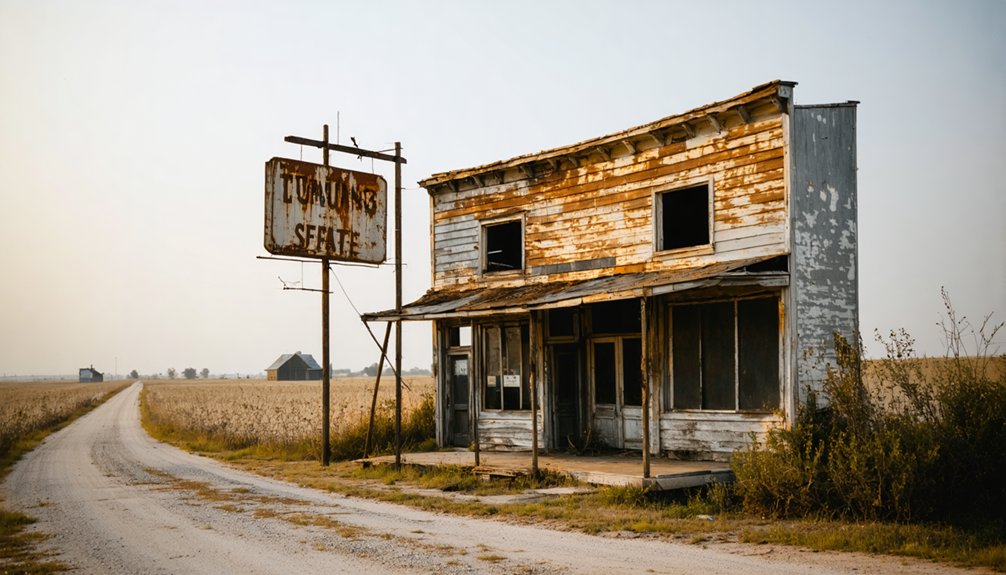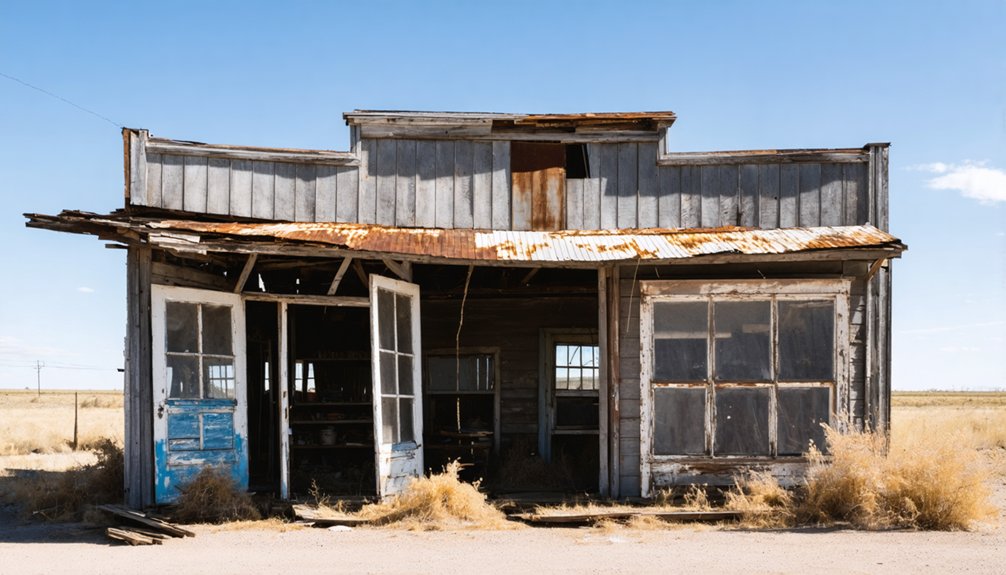You’ll find two ghost towns named Kirk in Texas – one in Bexar County and another in Limestone County. The Bexar County Kirk flourished as a railroad junction until the 1950s, while Limestone County’s Kirk served German settlers from the 1830s until its decline in 1914. Both towns shared agricultural roots but faced different fates: the railroad town faded with transportation changes, and the German settlement dwindled after its post office closed. Their stories reveal fascinating patterns in Texas’s rural development.
Key Takeaways
- Kirk was a transportation hub in Bexar County, Texas, that thrived during the 1930s-1950s before becoming a ghost town.
- The town’s decline began after World War II when trucking replaced railroad transportation, leading to economic collapse and depopulation.
- Two railroad lines intersected at Kirk, making it strategically important for freight and passenger transport until mid-20th century changes.
- Kirk’s post office closed in 1914, marking the beginning of community decline, with population dropping from 500 to under 100.
- The town’s bypass by Interstate 35 and rural migration sealed its fate as residents moved to better-connected urban areas.
Two Towns Named Kirk: A Tale of Different Destinies
While many Texas towns share similar names, the two communities called Kirk demonstrate starkly different historical trajectories.
You’ll find the railroad-driven Kirk in Bexar County had a brief but impactful existence from the 1930s to 1950s, centered around transportation networks at the junction of two major railways.
In contrast, Kirk in Limestone County emerged from German settlement patterns, with deeper cultural influences shaping its development.
Like many place names derived from ancient origins, these Texas communities reflect how the word Kirk means church in various Germanic and Scottish dialects.
The economic sustainability of these towns diverged greatly, similar to how dried-up springs led to the abandonment of towns like Lobo.
Bexar County’s Kirk couldn’t survive the post-World War II decline in rail transportation, becoming a ghost town by the 1950s.
Meanwhile, the agricultural and immigrant-based foundations of Limestone County’s Kirk provided more stability through its stronger community ties and diversified economic base, illustrating how different settlement patterns can determine a town’s longevity.
German Settlement Origins in Limestone County
The distinct German influences that shaped Limestone County’s Kirk can be traced back to the broader wave of German immigration to Texas during the 1830s.
You’ll find that these settlers, fleeing religious and political persecution in their homeland, brought their rich German heritage to the region through established settlement patterns that helped shape Kirk’s early development.
As you explore Kirk’s history, you’ll discover how German settlers arrived via coastal ports like Indianola before moving inland to Limestone County.
They chose locations based on access to fresh water and fertile soil, establishing farms and building communities centered around churches and schools. Like the settlers in Fredericksburg, they constructed shared religious centers to unite their community. Many settlers demonstrated remarkable resilience by rebuilding after storms to maintain their communities and way of life.
Railroad Junction Legacy in Bexar County
At Kirk’s junction point, you’ll find the convergence of the International-Great Northern and San Antonio Southern railroads, which served as a crucial transportation hub in southwestern Bexar County during the early 1900s.
The junction’s strategic location, about 14 miles southwest of San Antonio, supported both passenger transfers and agricultural freight movement through its depot and railway infrastructure. Kenney mine coal was transported through Kirk to power San Antonio’s industries. Today, railroad enthusiasts can learn more about Kirk’s history at Texas Transportation Museum, located on Wetmore Road in San Antonio.
Kirk’s significance gradually diminished after World War II as changing transportation needs led to its disappearance from maps by the 1950s, marking the end of its role in the region’s rail network.
Junction Point Development
Located in southeast Bexar County, Alamo Junction Rail Park represents a major advancement in regional railroad infrastructure, encompassing a 400-520 acre logistics hub that serves the bustling Eagle Ford Shale region.
This rail logistics powerhouse features 22,000 linear feet of track, including four 9,000-foot unit train loops that connect directly to Union Pacific and BNSF railways. The developer National Property Holdings is leading this transformative project from their Houston base.
You’ll find strategic positioning minutes from San Antonio’s major highways, enabling seamless transportation access for economic revitalization throughout the area. The site offers excellent ingress/egress through I-37, Highway 181, and Loop 1604.
The park’s infrastructure supports industrial utilities and regional detention facilities while catering to oilfield service giants like Baker Hughes and Halliburton.
With 100% net leasable sites and dual rail service options, you’re looking at a development that’s transforming Bexar County’s industrial landscape through enhanced shipping flexibility and operational efficiency.
Railroad Economic Decline
While modern rail facilities like Alamo Junction Rail Park showcase current industrial significance, Bexar County’s railroad history tells a different story of economic decline.
You’ll find that the county’s once-robust railroad infrastructure crumbled as trucking gained dominance in the mid-20th century. The shift dealt a devastating blow to small towns like Kirk, where economic sustainability depended heavily on rail operations. Historical records show that property value soared from under $1 million to over $4.7 million between 1850-1855 during the railroad’s peak influence. The arrival of the Galveston, Harrisburg and San Antonio Railway in 1877 initially stimulated tremendous population growth in the region.
Less-than-carload trucking services, refrigerated transport, and improved farm-to-market roads gradually stripped railroads of their freight business. The impact rippled through communities as agricultural producers and livestock operations abandoned rail shipping for more flexible road transport.
Local depots closed, branch lines were abandoned, and towns that had flourished as rail junctions faced isolation and depopulation, leaving behind stark reminders of railroad-dependent prosperity.
Post Office and Community Services
You’ll find Kirk’s post office operated from 1890 to 1914, serving as an essential hub for the German farming community alongside four stores and a cotton gin.
The post office’s sphere of influence extended throughout Limestone County before mail services consolidated with nearby Mart, Texas.
When the post office closed in 1914, it marked the beginning of Kirk’s transformation from a bustling agricultural center to a ghost town with just 10 residents by 2000.
Postal Operations Timeline
As a cornerstone of community life in Kirk, Texas, the local post office served as both a vital communications hub and social gathering point during the town’s peak settlement period in the late 19th to early 20th century.
You’d find the postal service operating at its height during these years, providing essential money order services and facilitating business transactions for local merchants and residents.
As transportation networks improved and nearby towns grew, Kirk’s community connectivity began to wane.
The post office’s decline mirrored the town’s diminishing population, following a pattern common to many rural Texas communities.
Mail routes were eventually restructured, and services were consolidated with neighboring towns, marking a significant milestone in Kirk’s transformation from a thriving community to its current ghost town status.
Mail Service Coverage Area
During its operational years from 1890 to 1914, Kirk’s post office served an essential mail coverage area centered around the local German farming community.
When Kirk’s postal operations closed, you’d find mail delivery services consolidated into Mart’s expanding network, reflecting a broader trend of rural consolidation throughout early 20th-century Texas.
If you lived in Kirk after 1914, you’d need to rely on Mart’s post office and its extended rural routes for your mail service.
This change meant longer travel distances to access postal facilities and less frequent deliveries.
The shift from a dedicated local post office to regional coverage mirrored the fate of many Texas ghost towns, where dwindling populations led to reduced postal infrastructure and reformed delivery networks following railroad and transportation corridors.
Community Hub Functions
Beyond its mail operations, Kirk’s post office formed the beating heart of a vibrant community hub from 1890 to 1914.
You’d find locals gathering at the post office to exchange news and maintain connections with the outside world, fostering strong community interaction and social cohesion.
The town’s four stores and cotton gin created a bustling atmosphere where residents could tend to their daily needs while strengthening neighborly bonds.
These establishments weren’t just places of business – they served as essential meeting points where you could catch up on local happenings and maintain relationships.
When the post office closed in 1914 and services consolidated with nearby Mart, you’d have witnessed the gradual unraveling of Kirk’s community fabric, marking the beginning of its change toward ghost town status.
Population Changes Through the Decades
Three distinct phases marked Kirk’s population trajectory from its 1870s founding to the present day.
The initial growth phase saw German farmers establish roots, with population dynamics reaching about 500 residents by the 1920s. You’d have found a bustling town with multiple stores, churches, and a thriving school system during this peak era.
Kirk’s vibrant heyday saw 500 German settlers create a flourishing community complete with schools, churches and commerce.
The stability phase lasted until World War II, when Kirk maintained its population while serving as a crucial hub for surrounding areas.
But the post-war period brought dramatic changes. Rural migration accelerated as modern farming methods reduced labor needs, triggering a steady decline. By the 1980s, you’d have seen the population plummet to roughly 100 residents.
Today, Kirk’s remaining 44 to 100 inhabitants reflect the stark reality of rural Texas depopulation.
Agricultural Roots and Economic Activities

Fertile soil and strategic railway connections formed the twin pillars of Kirk’s agricultural economy from its founding.
You’ll find that early settlers quickly capitalized on the land’s potential, establishing a diverse mix of crop farming and cattle ranching operations. Kirk’s agricultural heritage thrived at the intersection of the International-Great Northern Railroad and San Antonio Southern Railway, enabling farmers to ship their goods to distant markets.
The town’s economic resilience stemmed from a network of agricultural businesses, including mercantile stores supplying essential farming equipment and supplies.
One notable establishment later evolved into Furr’s Groceries and Cafeterias. Despite challenges like the Panic of 1893, Kirk’s agriculture-based economy demonstrated remarkable adaptability, supported by local banking and service industries catering to the farming community.
Transportation’s Impact on Development
The rise and fall of Kirk, Texas, was inextricably linked to its transportation infrastructure.
You’ll find that Kirk’s early growth stemmed from its position along stage line routes, where travelers’ needs spawned inns, stores, and saloons.
The town’s economic transformation accelerated when it became a strategic junction between the International-Great Northern Railroad and San Antonio Southern Railway in the 1930s.
But Kirk’s fortune wouldn’t last.
After World War II, America’s shift toward automobile travel dealt a crushing blow to this railroad town.
Even its proximity to Interstate 35 couldn’t save it – the highway bypassed Kirk entirely, and residents moved to better-connected urban areas.
The Path to Ghost Town Status

As Kirk weathered the financial storms of the late 19th century, including the Panic of 1893, its path toward ghost town status began taking shape through a complex interplay of economic and social forces.
The town’s economic resilience gradually eroded in the post-1920s era, when shifting transportation routes bypassed the once-vital railway junction.
Prosperity slipped away as new transportation networks left Kirk’s railway hub behind, slowly draining the town’s economic lifeblood.
You’d find the most dramatic changes after World War II, when urban migration drew younger residents to bigger cities for jobs and education.
The closure of essential services – schools, post offices, and stores – created a downward spiral. Without these institutions, remaining residents faced mounting pressure to relocate.
Competition from neighboring towns that secured better transport routes and infrastructure sealed Kirk’s fate, transforming it from a promising settlement into another Texas ghost town.
Historical Significance and Texas Settlement Patterns
Kirk’s historical significance stretches far beyond its eventual decline, offering valuable insights into broader Texas settlement patterns of the late 19th century.
You’ll find that Kirk’s development mirrors the typical progression of frontier towns, starting as a stagecoach stop before repositioning itself near the railroad to capitalize on new transportation opportunities.
The town’s economic resilience through the Panic of 1893 demonstrates how diverse commercial activities, including agriculture and mercantile trade, helped sustain these communities.
Kirk’s legacy includes spawning Furr’s Groceries and Cafeterias, an indication of the entrepreneurial spirit that shaped Texas commerce.
The town exemplifies how settlement patterns followed transportation corridors, with communities either adapting to changing routes or facing obsolescence – a common thread in Texas frontier history.
Frequently Asked Questions
Are There Any Remaining Structures or Ruins in Either Kirk Location?
Time has taken its toll – you won’t find any abandoned buildings today. Despite historical preservation efforts elsewhere in Texas, Kirk’s structures haven’t survived, leaving no visible ruins at either location.
What Happened to the Original German Families Who Settled Kirk?
You’ll find most original German families dispersed to nearby towns or cities after 1940, though their German Heritage lives on through descendants who’ve preserved their Family Legacy throughout Texas.
Did Native Americans Have Settlements Near Either Kirk Location?
Like scattered seeds across fertile soil, you’ll find Native settlements were indeed prominent near Kirk. The Caddo, Cherokee, Delaware, Tonkawa, and Kickapoo tribes left historical significance throughout the North Texas region.
Were There Any Notable Crimes or Incidents in Kirk’s History?
You’ll find two major violent incidents in Kirk’s history: Sheriff Harvey Cox’s death by assault in 1864 and Sheriff Richard Kirk’s violent death in 1876 while performing his law enforcement duties.
What Natural Disasters Affected the Development of These Communities?
You’ll find that 1930s droughts devastated 80% of local cotton crops. Extended dry spells and severe water shortages crippled agriculture and livestock, while shifting railroad routes dealt the final blow to these fragile communities.
References
- https://en.wikipedia.org/wiki/Kirk
- https://discovertexasoutdoors.com/places/kirk/
- https://www.tshaonline.org/handbook/entries/kirk-tx-bexar-county
- https://929thelake.com/texas-ghost-towns/
- https://www.ctpost.com/news/slideshow/Ghost-towns-around-Texas-95681.php
- https://authentictexas.com/texas-ghost-towns/
- https://www.yourconroenews.com/neighborhood/moco/news/article/ghost-town-history-fostoria-waukegan-danville-19835994.php
- https://www.tshaonline.org/handbook/entries/kirk-tx-limestone-county
- https://texashighways.com/travel-news/four-texas-ghost-towns/
- https://www.youtube.com/watch?v=PR_gr_c56No



